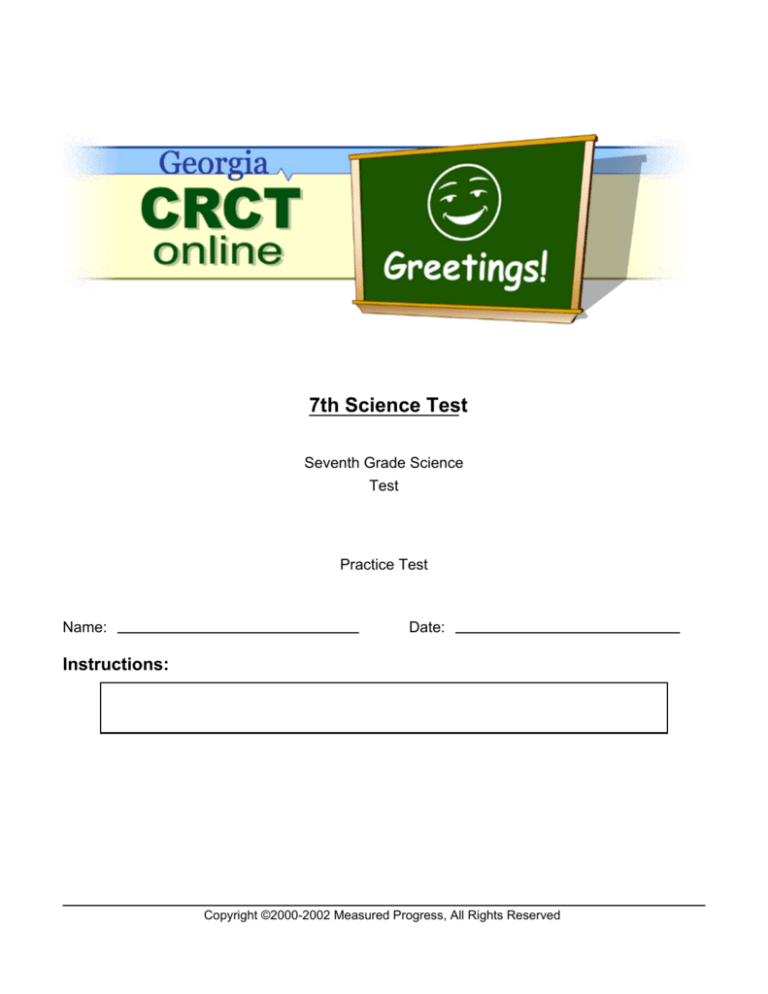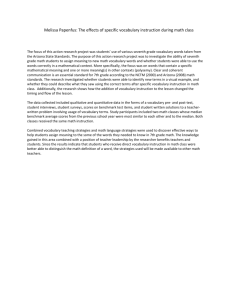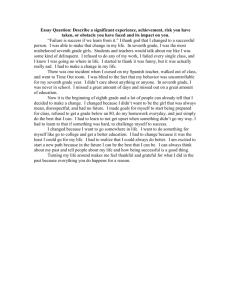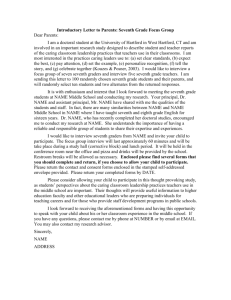
7th Science Test
Seventh Grade Science
Test
Practice Test
Name:
Date:
Instructions:
Copyright ©2000-2002 Measured Progress, All Rights Reserved
Name:
Test:
7th Science Test
Date:
Teacher:
Practice Test
1. Grasslands and savannas are biomes that are very valuable as areas for farming and grazing livestock.
In the United States, these biomes are mostly found in the
A.
B.
C.
D.
Southeast.
Midwest.
Northwest.
Southwest.
2. Fossils show that the first horses looked somewhat like today’s horses but they were only as big as
today’s goats. According to the theory of evolution, which best explains this change in size?
A.
B.
C.
D.
Larger horses could hunt for food better than the smaller horses.
The larger size was an advantage for survival of the horse species.
Better food with more nutrients caused horses to grow larger.
Larger mammals bred with the small horses to produce larger horses.
3. One characteristic feature of tundra is that only the surface thaws in the summer and refreezes in the
winter, leaving a layer of permanently frozen subsoil. This characteristic is known as
A.
B.
C.
D.
hoarfrost.
glaciation.
permafrost.
crystallization.
Seventh Grade Science
2
Test
Name:
Test:
7th Science Test
Date:
Teacher:
Practice Test
Use the pictures below to answer question 4.
4. Which leaf can capture the most sunlight?
A.
B.
C.
D.
Leaf A
Leaf B
Leaf C
Leaf D
5. Wrinkled seeds are a recessive trait of pea plants, while plump seeds are a dominant trait. If a pure
(homozygous) wrinkled-seed plant is crossed with a pure plump-seed plant, which result would be
expected regarding the offspring?
A.
B.
C.
D.
All would produce plump seeds.
All would produce wrinkled seeds.
More would produce plump seeds than wrinkled seeds.
More would produce wrinkled seeds than plump seeds.
6. In a pond environment there are bacteria (Monera), protozoa (Protista), water hyacinths (Plantae),
and minnows (Animalia). Which of these organisms could exist at the bottom of the pond food web?
A.
B.
C.
D.
bacteria and protozoa
hyacinths and minnows
protozoa and hyacinths
bacteria and hyacinths
Seventh Grade Science
3
Test
Name:
Test:
7th Science Test
Date:
Teacher:
Practice Test
Use the classification table below to answer question 7
7. While walking on the beach Geraldine found an organism that had no regular shape or symmetry and
had a lot of body openings. She should conclude that it belongs to the class
A.
B.
C.
D.
Porifera.
Cnidaria.
Nematoda.
Platyhelminthes.
8. Which general principle has guided the development of the life forms that exist at the present time?
A.
B.
C.
D.
predator-prey relationships
consumer dominance
natural selection
trait inheritance
Seventh Grade Science
4
Test
Name:
Test:
7th Science Test
Date:
Teacher:
Practice Test
9. A biology class on a field trip traveled just a few miles to observe examples of three major biomes: a
temperate deciduous forest, a coniferous taiga forest, and a tundra environment. Where were they
probably traveling?
A.
B.
C.
D.
along the US – Canada border
in northern Canada
in the mountains of Colorado
along the Georgia Blue Ridge Trail
10. How much genetic material is found in a cloned cell as compared to the original cell?
A.
B.
C.
D.
twice as much
the same amount
half as much
one-fourth as much
11. The number of chromosomes in a cell produced by meiosis is
A.
B.
C.
D.
half as many as the original cell.
twice as many as the original cell.
the same number as the original cell.
not predictable.
12. DNA controls heredity by
A.
B.
C.
D.
directing the formation of genes.
directing the construction of proteins.
preventing dominant characteristics.
preventing recessive characteristics.
Seventh Grade Science
5
Test
Name:
Test:
7th Science Test
Date:
Teacher:
Practice Test
Use the pictures below to answer question 13.
13. The pictures show cells from the same animal. Which of the following best explains why the cell in
Picture I looks so different from the cells in Picture II?
A.
B.
C.
D.
The cells have different DNA.
The cells have different functions.
The cells in Picture II are very young and still growing.
The cell in Picture I is diseased and damaged.
Seventh Grade Science
6
Test
Name:
Test:
7th Science Test
Date:
Teacher:
Practice Test
Use the diagram below to answer question 14.
14. What is the level of liquid in the beaker?
A.
B.
C.
D.
240 mL
250 mL
260 mL
360 mL
15. The role of the mitochondria in a living cell is to
A.
B.
C.
D.
produce energy for the cell.
act as the control center of the cell.
store materials in the cell.
rid the cell of waste materials.
16. Which organism is likely to be at the beginning of a food chain for a pond?
A.
B.
C.
D.
sunfish
freshwater shrimp
paramecium
green algae
Seventh Grade Science
7
Test
Name:
Test:
7th Science Test
Date:
Teacher:
Practice Test
17. How do the heart and lungs work together?
A.
B.
C.
D.
The lungs supply oxygen to the blood that the heart pumps throughout the body.
The heart and the lungs work together to digest food.
The movement of the lungs helps the heart to pump blood.
The lungs push oxygen into cells that make food for the heart.
18. What can a green plant cell do that an animal cell cannot?
A.
B.
C.
D.
make its own food
move from one place to another
take in and release gases
reproduce itself
Seventh Grade Science
8
Test
Name:
Test:
7th Science Test
Date:
Teacher:
Practice Test
Use the diagram below to answer question 19.
19. This life cycle of the fern is an example of alternation of generations. In the fern life cycle, the
gametophyte generation is represented by
A.
B.
C.
D.
sporangium.
prothallus.
rhizome.
frond.
Seventh Grade Science
9
Test
Name:
Test:
7th Science Test
Date:
Teacher:
Practice Test
20. Which diagram shows that the fox is the secondary consumer?
A.
B.
C.
Seventh Grade Science
10
Test
Name:
Test:
7th Science Test
Date:
Teacher:
Practice Test
D.
21. Which best describes a desert biome?
A.
B.
C.
D.
no rain, pure sand for soil, very hot year- round, flat
almost no rain, sand dunes, occasional water holes
low rainfall, gravel-clay-sandy soil, hot-to-cold temperatures
dry, rocky creek beds, large glacial rocks, severe erosion
22. The stringy part of celery is cellulose, which makes up the cell walls of plants. What is the function
of cellulose?
A.
B.
C.
D.
to make food in plant cells
to help the plant reproduce
to transport water through the plant
to provide support for the plant
Seventh Grade Science
11
Test
Name:
Test:
7th Science Test
Date:
Teacher:
Practice Test
Use the food chain below to answer question 23
grass
grasshopper
mouse
hawk
23. Which of the living things in the food chain is a producer?
A.
B.
C.
D.
hawk
mouse
grasshopper
grass
Use the list below to answer question 24
Steps in the Digestive Process
1. Water and vitamin absorption begins.
2. Food is liquefied; breakdown of proteins begins.
3. Food is moistened; breakdown of starch begins.
4. Proteins, carbohydrates, and fats break down; nutrients are absorbed into the bloodstream.
24. The steps listed above are out of order. What is the correct order of these events as food passes
through the human digestive tract?
A.
B.
C.
D.
2, 4, 1, 3
4, 2, 3, 1
1, 3, 2, 4
3, 2, 4, 1
Seventh Grade Science
12
Test
Name:
Test:
7th Science Test
Date:
Teacher:
Practice Test
Use the table below to answer question 25.
25. Beth wanted to know which area of her body was most sensitive to touch. Her friend lightly pressed
the points of two toothpicks on Beth’s back, 5 centimeters apart. Beth could feel the two different
points, so the friend moved the toothpicks a bit closer. These steps were repeated until Beth felt only
one point. Three other body parts were tested in the same way. According to the table, which body
part was the most sensitive to touch?
A.
B.
C.
D.
back
inside of arm
bottom of foot
palm
26. Which reproductive structure is found in the life cycles of mosses and ferns?
A.
B.
C.
D.
spores
uncovered seeds
covered seeds
bulbs
Seventh Grade Science
13
Test
Name:
Test:
7th Science Test
Date:
Teacher:
Practice Test
27. Julia wondered if light has an effect on the growth of bacteria. To test her idea, which variable should
remain constant?
A.
B.
C.
D.
temperature
light intensity
time of day
shape of the container
Use the graph below to answer question 28.
28. Caffeine is known to increase the heart rate of animals. This graph was made by a student who gave
increasing amounts of caffeine to a goldfish as another student measured its heart rate.
Which best predicts what would happen to the goldfish heart rate if the student continued to increase
the amount of caffeine given?
A.
B.
C.
D.
It would decrease by as much as it increased in the early part of the experiment.
It would decrease at first but then increase by a lot more.
It would increase but by lesser amounts than earlier in the experiment.
It would increase by more than it did when only a small amount of caffeine was given.
Seventh Grade Science
14
Test
Name:
Test:
7th Science Test
Date:
Teacher:
Practice Test
29. The theory of evolution is based upon what general principle?
A.
B.
C.
D.
Individuals must adapt to environmental changes.
Mutations generally produce stronger organisms.
The most fit organisms survive to reproduce.
All organisms will eventually adapt to changes.
30. We get energy from food. The energy in the food first comes from
A.
B.
C.
D.
nutrients in the soil left by decomposers.
the fertilizers used by farmers to make plants grow faster.
the vitamins and minerals added by food manufacturers.
the Sun’s energy trapped in food by producers.
Seventh Grade Science
15
Test






